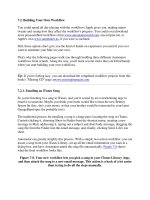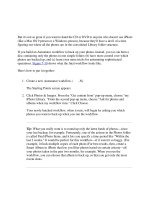Building Your PageRank Through Networking
Bạn đang xem bản rút gọn của tài liệu. Xem và tải ngay bản đầy đủ của tài liệu tại đây (990.59 KB, 18 trang )
Chapter 3
Building Your PageRank
Through Networking
In This Chapter
ᮣ
Understanding the importance of incoming links to Google PageRank
ᮣ
Networking personally with other Webmasters
ᮣ
Working the link exchanges
ᮣ
Coding effective links back to your site
ᮣ
Publishing articles and using sig files
ᮣ
Evaluating your incoming link network
G
oogle’s PageRank is probably the most observed, mysterious, important,
and craved statistic in the entire online marketing field. This might be
especially true among the vast numbers of entrepreneurs, Webmasters, small
businesses, medium businesses, thriving businesses, struggling businesses,
online stores, service sites, and other enterprises not up to the level of clout
enjoyed by Amazon.com, eBay, Yahoo!, and other Internet juggernauts. For
nearly all online ventures, visibility in Google is a marketing imperative — and
PageRank determines a site’s visibility.
As described in Chapter 2, PageRank is the result of Google’s internal ranking
algorithm. (You can view a crude version of any site’s PageRank by calling up
that site while running the Google Toolbar.) Although PageRank’s formulas
and specific results aren’t publicized, enough is known about it — partly
through trial and error, and partly through Google’s sparse proclamations —
to catalyze entire marketing niches devoted to raising a site’s PageRank.
The value of improving a site’s PageRank lies in positioning: Highly ranked
pages appear close to the top of Google’s search results lists. Positioning is
determined also by which search page is being displayed, and there are as
many unique search pages as there are keyword combinations. The goal is to
place your site high on search results pages that closely correlate with your
site’s subject. A high PageRank always boosts a site’s position relative to sim-
ilar sites.
07_571435 ch03.qxd 5/21/04 11:28 PM Page 37
Jockeying for position in search engines is not a new sport. To the contrary,
Webmasters have engaged in the contest for high search-result positions for
years. Google’s increasing dominance in the field has concentrated the most
meaningful screen real estate onto a single engine’s result pages, and compe-
tition for that space has become ferocious. Winning techniques have become
more demanding, precise, and artful. The field of search engine optimization
(SEO) covers other engines besides Google, but much more attention is paid
to Google’s search results than to those of any other single engine.
Competition for Googlespace is cruel. Broad subject areas such as music,
news, or baseball are jammed with major industrial sites, and breaking into
the rarefied atmosphere clotted with corporate behemoths such as MTV.com,
CNN.com, and MLB.com is, for the most part, impossible. Google’s default
display setting shows only 10 results on the user’s search page. (This setting
can be extended to 100 listings, but many people don’t bother.) Google’s rep-
utation for delivering the best sites, fast, discourages casual searching
beyond the first page. So the pressure is on to break into the top 10.
The good news is that getting near the top of the list is doable for narrower,
precisely targeted subjects. It’s not unusual for sole proprietors of commer-
cial sites to score the top position in a Google search of targeted keyword
phrases.
Google strives to be, and largely is, democratic. The ranking of Google search
results is based on merit and popularity. Any Web site, large or small, can
gain favorable positioning by leveraging good content, diligent networking,
and smart optimizing.
Incoming Links and PageRank
One key to higher PageRank is getting linked on other sites. PageRank is a
complicated algorithm, and largely a secret one, but Google acknowledges
that the number of links pointing to a site is the largest single factor of that
site’s PageRank. The two major marketing efforts to undertake when building
your business with Google are creating incoming links and optimizing your
site. This chapter is devoted to incoming links, and Chapter 4 is about opti-
mization; each contributes enormously to a site’s PageRank, overall visibility,
and marketing success.
In theory, any single page currently crawled by Google (that is, currently in
the index) that links to your page or site is enough to send Google’s spider
crawling toward you. In practice, you want as many incoming links as possi-
ble, both to increase your site’s chance of being crawled (which sounds a
little creepy) and to improve your site’s PageRank once in the index.
38
Part I: Meeting the Other Side of Google
07_571435 ch03.qxd 5/21/04 11:28 PM Page 38
39
Chapter 3: Building Your PageRank Through Networking
Developing incoming links (from other pages to yours) is a major part of the
Google optimization process. Online entrepreneurs seeking to drive traffic
to their sites through Google spend immense portions of their development
time networking. This networking is accomplished the old-fashioned way —
by introducing oneself and talking to other Webmasters — and also through
more impersonal means. The following section discusses human networking;
I cover link exchanges, which are less personal, in the section after that.
Human Networking
Building a link network by hand, as it were, involves contacting other sites,
introducing yourself, and asking to be linked — it’s as simple as that. Offering
to link back in return smoothes the way to a reciprocal agreement in many
cases, but the willingness to trade links doesn’t mean you should approach
other sites indiscriminately. Keeping your network relevant to the topic of
your site has two benefits:
ߜ First, you are more likely to succeed when you have something of value
to offer — namely, the relevance of your site. Other Webmasters are
more interested in trading links with sites likely to send traffic their way,
and that sort of traffic-sharing happens mostly among related sites.
The dual role of networking
Links from one site to another not only help
Google find a target site when it is new but also
contribute to the target site’s PageRank. Among
other considerations, Google’s ranking algorithm
measures each page’s popularity based on the
number of other pages that link to it. The theory
is that if Page A puts up a link to Page B, there
must be something worthwhile on Page B. If 100
sites link to Page B, the target page becomes
more worthy in Google’s eyes. If 100,000 links to
Page B are scattered around the Web, Page B
must really have something going for it. From
Google’s viewpoint, Page B must have special
value to Google’s users, and therefore deserves
higher positioning on the search results page
when it matches the search keywords.
Google doesn’t rely totally on counting back-
links, by any means. Many other page-analysis
calculations take place when determining
PageRank. Even the counting of backlinks is
more complex than it seems at first, because
Google also evaluates the worthiness of the
referring pages (the pages linking to Page B) to
determine how important those backlinks are.
The outcome of all this evaluation, from the
user’s viewpoint, is a sense of the living network
underlying all Web pages and sites. No single
page in the Google index exists in isolation —
they’re all embedded in a deeply complex matrix
of connectivity.
For the Webmaster and online marketer, Google
offers a glimpse into the effectiveness of any
site’s networking, and the status it enjoys
among its peers.
07_571435 ch03.qxd 5/21/04 11:28 PM Page 39
ߜ Second, placing irrelevant outgoing links on your pages devalues your
own site. Diluting the editorial focus of your page (and yes, even a single
link undermines that focus) is always a poor optimization move. Google
notices, too; the spider examines outgoing and incoming links with
remarkable fastidiousness. Irrelevant links tend to lower the PageRank of
your page and the pages you link to.
Exchanging links is sometimes a simple and courteous agreement. More sub-
stantial alliances might include sharing content. If you run a site about dogs and
come across a great article about how to train garden-trampling Labradors, you
could offer to trade an article of your own in exchange for the right to post the
lab article. Each article would contain a link to the originating page.
Broadly speaking, you want incoming links to point to your top page, or index
page. The danger of requesting that incoming links point to inner pages that
exactly match the topical focus of the other site is that you could end up with
an unfocused network of incoming links aimed at various pages all over your
site. From the PageRank-building perspective, such a diverse backlink situa-
tion does you little good. There’s nothing wrong with putting attention on an
important inner page and cultivating its individual PageRank. The point is to
gather your efforts into a PageRank campaign likely to raise the stature of
your most important business content in Google. In most cases, that means
getting your main page, the one with navigation links to all your other pages,
as high as possible in Google’s search results for relevant keywords.
Working the Link Exchanges
Link exchange sites offer a formal method of exchanging links, with an empha-
sis on raising Google PageRank. The best of these clearinghouses function
also as topical directories built by participating sites that submit their links
(see Figure 3-1).
In a nutshell, link exchange sites work by supplying an outgoing link to your
site (an incoming link, or backlink, from your perspective) and asking for an
incoming link from you in return. There is sometimes no standard of accep-
tance, application process, or human communication between you and the
link exchange. You simply type your site information into a form (see Figure
3-2), and within a short time the link to your site is created. You have an
informal obligation to return the favor at your site, which, when multiplied by
the many participants in the exchange, helps raise the PageRank of the link
exchange site. Most link exchanges operate free of charge to the participants.
40
Part I: Meeting the Other Side of Google
07_571435 ch03.qxd 5/21/04 11:28 PM Page 40
Although the preceding description covers many bases, the link exchange
field is complicated. Two major variations are prevalent:
ߜ Paid link building. Certain online marketing companies specialize in
building incoming link networks for their clients. Ideally, they approach
high-quality sites with strong relevance to the client site (in other words,
similar sites with high PageRank), and request placement of a link to the
client site. Content exchange is usually not involved. These services act
as agents on your behalf and work best when your site is good enough
to benefit other sites by linking to you.
ߜ Link farms. These exchanges build vast numbers of outgoing links with
indiscriminate disregard for topicality or any sort of editorial policy.
Only a fine line distinguishes legitimate link exchanges that accept site
information automatically and link farms. Google doesn’t like link farms.
Remember that Google’s spider has an inclusive robotic eye with great
peripheral vision. It sees the truth about link connections and their hon-
esty. Building your backlink network around link farms can do you little
good and might penalize your PageRank.
Figure 3-1:
A link
exchange
site that
offers a
real estate
directory.
41
Chapter 3: Building Your PageRank Through Networking
07_571435 ch03.qxd 5/21/04 11:28 PM Page 41
Google claims to distinguish link farms from meaningful link exchanges, and
generally discourages using any kind of link exchange site that contains no
content besides the links to build PageRank. Choose carefully. The more edi-
torial discretion exercised by the site, the more legitimate it probably is. Use
exchanges that maintain a tight topical focus in your field. A general rule is:
The more personal the link exchange, the more valuable the incoming link.
Link exchanges work on the principle that a rising tide lifts all boats. If the
exchange site benefits from a high PageRank (thanks to dozens of incoming
links from participating sites), its enhanced stature in Google bolsters the
PageRank of each participating site. The best and most honorable link
exchanges concentrate their networks in one certain field, in which case the
rising tide is lifting the boats of sites that naturally are in competition. The
mutual benefit is well and good, but the challenge remains to distinguish one-
self from the high-floating crowd and keep ascending on the search results
page. Site optimization techniques described in Chapter 4 can help with that.
When assessing link exchanges, select sites with a reasonably high PageRank —
say, 4 or higher. The higher PageRank benefits your own PageRank when Google
evaluates the backlink. A high PageRank also provides a kind of Google “stamp
of approval,” which might not be forthcoming at a less reputable link farm. (To
easily see a site’s PageRank, use the Google Toolbar. For example, in Figure 3-1,
the Google Toolbar lists a PageRank of 6.)
Figure 3-2:
A standard
link-
submission
form at
a link
exchange.
HTML code
is provided
for the
reciprocal
link.
42
Part I: Meeting the Other Side of Google
07_571435 ch03.qxd 5/21/04 11:28 PM Page 42
Coding Effective Link Exchanges
Links are simple to use — one click sends the surfer to another page — but
more complex behind the scenes. Rudimentary knowledge of HTML link code is
needed to optimize your incoming links, and that’s what this section gives you.
In most link exchanges, you either provide the complete HTML code for your
link or fill in a form that’s then used to construct the code. When personally
trading links with another site, you might not need to provide complete code
for your partner’s use, but doing so maximizes the value of that backlink.
The following information might seem excessively detailed, but it meets the
Google spider at its own level. Do not ignore this stuff. Google optimization is
all about detail.
The underlying code of any incoming link consists of three parts:
ߜ URL of the link’s target page. This is the link’s destination address.
ߜ Link title. This text appears when a visitor hovers the mouse over the
link.
ߜ Anchor text. This is the (usually underlined) link itself, seen and clicked
by visitors.
<a> </a>
As with most other HTML tags, the opening tag (
<a>
) indicates the presence
of some content that is influenced by the tag, and the closing tag (
</a>
) indi-
cates that the tag is finished and its influence has ended. Between these two
tags, you place your anchor text. (Remember, the anchor text is what the visi-
tor sees and clicks.)
When creating the three parts of a link, the keys are relevance and consis-
tency. Let’s say your hobby is trading old coins. You operate a trading site
called The Coin Trader, and the site URL is
www.the-coin-trader.com
. (No
such site exists as of this writing.) The simplest way to create a powerfully
consistent link that Google will respect is to use the words “the coin trader”
in all three parts, like this:
<a href=”” title=”The Coin
Trader”>The Coin Trader</a>
Google looks at that link with approval, because its topicality is crystal clear.
(Figure 3-3 illustrates this link as it appears on a Web page.)
43
Chapter 3: Building Your PageRank Through Networking
07_571435 ch03.qxd 5/21/04 11:28 PM Page 43









